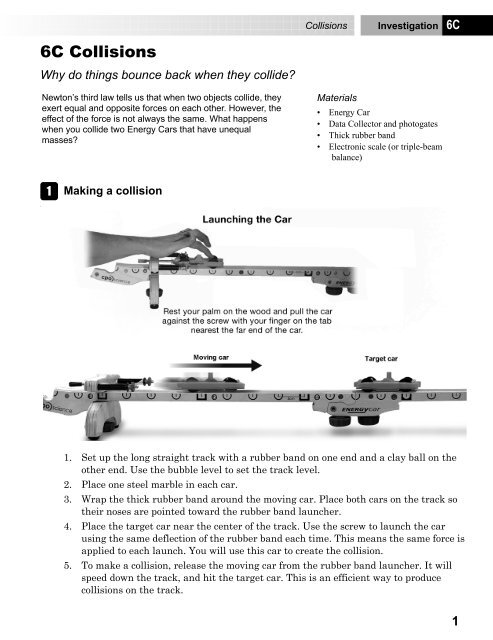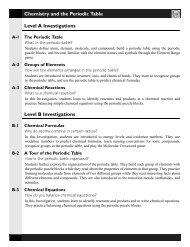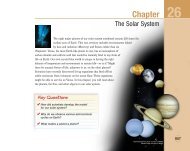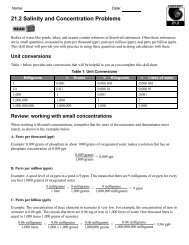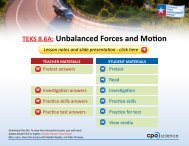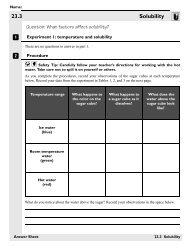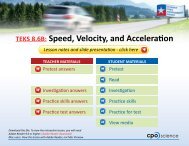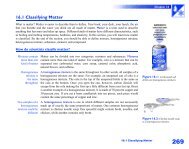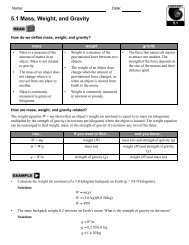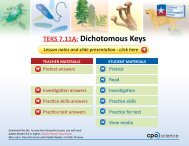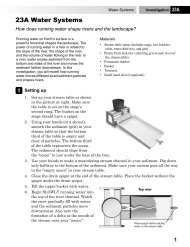6C Collisions - CPO Science
6C Collisions - CPO Science
6C Collisions - CPO Science
Create successful ePaper yourself
Turn your PDF publications into a flip-book with our unique Google optimized e-Paper software.
<strong>Collisions</strong> Investigation <strong>6C</strong><br />
<strong>6C</strong> <strong>Collisions</strong><br />
Why do things bounce back when they collide?<br />
Newton’s third law tells us that when two objects collide, they<br />
exert equal and opposite forces on each other. However, the<br />
effect of the force is not always the same. What happens<br />
when you collide two Energy Cars that have unequal<br />
masses?<br />
Materials<br />
• Energy Car<br />
• Data Collector and photogates<br />
• Thick rubber band<br />
• Electronic scale (or triple-beam<br />
balance)<br />
A<br />
1<br />
Making a collision<br />
1. Set up the long straight track with a rubber band on one end and a clay ball on the<br />
other end. Use the bubble level to set the track level.<br />
2. Place one steel marble in each car.<br />
3. Wrap the thick rubber band around the moving car. Place both cars on the track so<br />
their noses are pointed toward the rubber band launcher.<br />
4. Place the target car near the center of the track. Use the screw to launch the car<br />
using the same deflection of the rubber band each time. This means the same force is<br />
applied to each launch. You will use this car to create the collision.<br />
5. To make a collision, release the moving car from the rubber band launcher. It will<br />
speed down the track, and hit the target car. This is an efficient way to produce<br />
collisions on the track.<br />
1
Investigation<br />
<strong>6C</strong><br />
<strong>Collisions</strong><br />
a. Does the moving car bounce back after the collision?<br />
b. Does the moving car keep going forward after the collision?<br />
c. Does the moving car stop at the collision?<br />
d. How does the target car behave?<br />
B<br />
Thinking about what you observed<br />
a. Describe in words the motion of the two cars before and after the collision.<br />
b. The target car must exert a force on the moving car to stop it. How strong is this force<br />
relative to the force the moving car exerts on the target car to get it moving? How could<br />
you use the photogates to provide evidence for your answer?<br />
2
<strong>Collisions</strong> Investigation <strong>6C</strong><br />
C<br />
1<br />
Gathering evidence<br />
1. Try the experiment again, but now use two photogates to collect time data.<br />
2. Place two photogates on the square marks near the middle of the track.<br />
3. Put the target car on the track so it is near photogate beam B.<br />
4. Release the moving car from the rubber band launcher as before and make a collision.<br />
5. Repeat several times and record trial Times in Table 1.<br />
Table 1: Collision Times<br />
Collision Trial<br />
1<br />
2<br />
3<br />
4<br />
5<br />
Time for moving car to<br />
pass through A before<br />
collision (s)<br />
Time for target car to pass<br />
through B after collision<br />
(s)<br />
3
Investigation<br />
<strong>6C</strong><br />
<strong>Collisions</strong><br />
a. Newton’s third law tells us that when the moving car exerts a force on the target car, the<br />
target car exerts an equal and opposite force on the moving car. Does your data provide<br />
evidence for this? Explain.<br />
b. You can compare times through A and B for each individual trial. How can using these<br />
times show there are equal and opposite forces at work?<br />
D<br />
1<br />
Changing the masses<br />
Try the experiment with the four combinations of mass shown above. You do not need to use<br />
photogates for this part of the investigation.<br />
E<br />
Applying what you have learned<br />
a. Describe the motion of the two cars when the target car has more mass than the moving<br />
car.<br />
b. Describe the motion of the two cars when the target car has less mass than the moving<br />
car.<br />
4
<strong>Collisions</strong> Investigation <strong>6C</strong><br />
c. Explain how your observations support the idea that there are action and reaction forces.<br />
d. If the action and reaction forces are equal in strength, why does one car move at a<br />
different speed after the collision than the other car when the masses are unequal?<br />
Hint: the answer involves the second law.<br />
5


